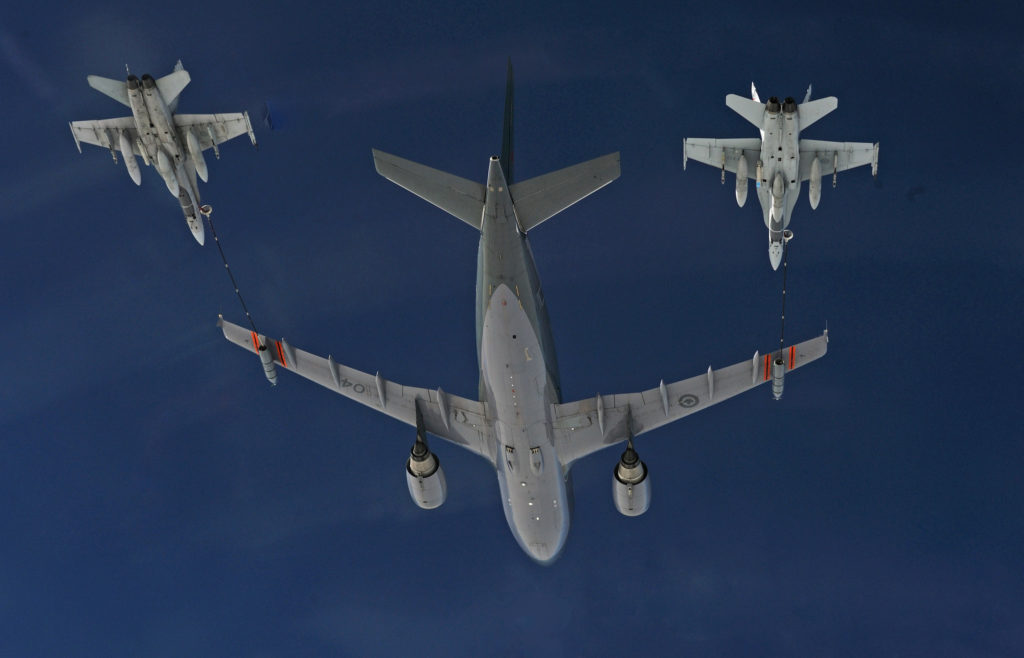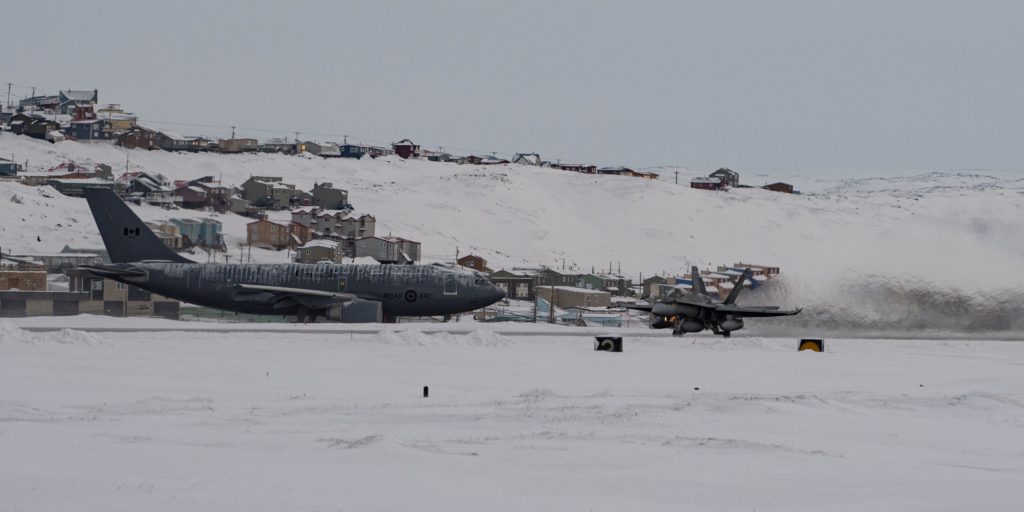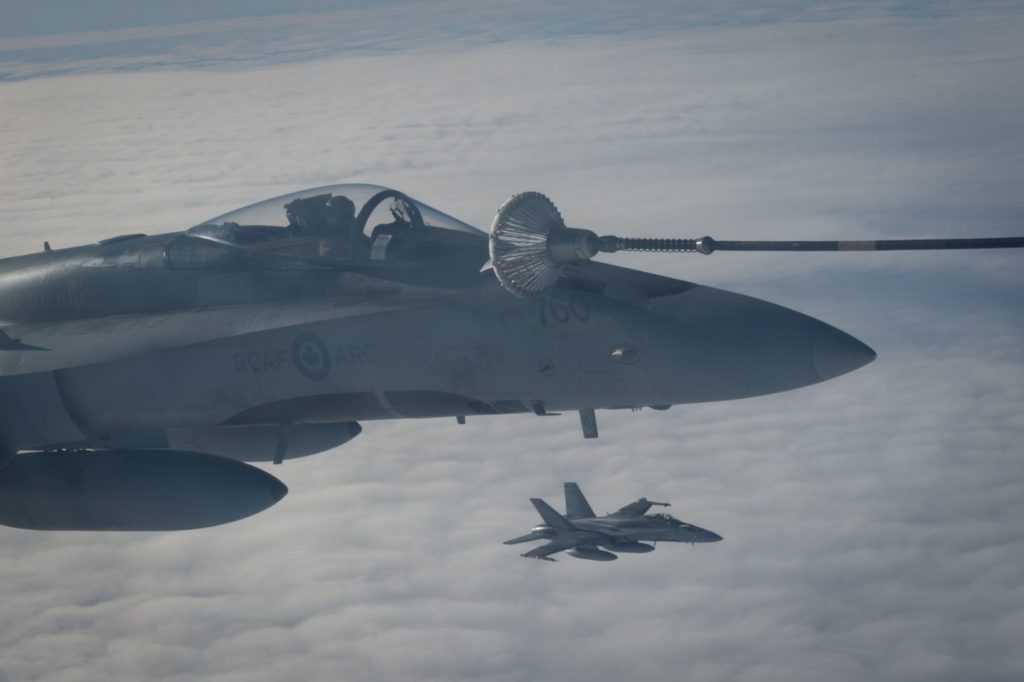Estimated reading time 12 minutes, 47 seconds.
In the fall of 2020, the Royal Canadian Air Force (RCAF) quietly declared two CC-150T Polaris aircraft fully capable of conducting air-to-air refueling on NORAD operations, a crucial step toward the eventual retirement of the CC-130H Hercules as an air-to-air tanker.
The Polaris aircraft, operated by 437 Transport Squadron at 8 Wing Trenton, Ontario, have been refueling Canadian and coalition fighter jets globally since 2008. One was deployed on Operation Impact, a coalition effort to defeat Daesh in Iraq and Syria, and conducted 1,166 sorties between Oct. 30, 2014, and Jan. 24, 2019. Most recently in mid-January, a CC-150T escorted six CF-188 Hornets home to 3 Wing Bagotville, Quebec, from a NATO air policing mission in Romania.

But until 2020, the strategic airlift and aerial tankers had not been certified or employed in support of NORAD quick reaction alert (QRA) duty. Mid-air refueling of CF-188s responding to possible incursions of Canadian and United States airspace, known as identification zones, was provided by the CC-130 H-model Hercules operated by 435 Transport and Rescue Squadron from 17 Wing Winnipeg, Manitoba, and by United States Air Force assets such as the KC-135 Stratotanker operating from Eielson Air Force Base in Alaska.
“We have used our Herc tankers a lot. We haven’t used our CC-150T much yet. But that is my intent over the next [few years] to see the use of that a lot more in the NORAD role,” MGen Eric Kenny, commander of 1 Canadian Air Division, told Skies in a recent interview.
The Polaris is a modified variant of the Airbus A310-300 built in the late 1980s. A fleet of five were acquired in 1992 from Canadian Airlines, and two were converted to tankers in 2008.
CC-150T crews began the transition to NORAD air-to-air refueling operations about a year ago, and achieved initial operating capability (IOC) in July. The capability was certified during a real-world NORAD deployment to Yellowknife and Inuvik in the Northwest Territories in mid-June, where the tanker met up with two Hornets over the Beaufort Sea as they responded to a QRA call.
Though CC-150T crews have over a decade of experience refueling a range of coalition fighter jets, the Canadian Air Defence Sector at 22 Wing North Bay, Ontario, has specific “command and control relationships that are required in the NORAD mission,” Kenny explained.
“Their air-to-air refueling procedures are the same [anywhere in the world], but the command and control (C2) is different at each location, so you need to understand the special instructions and rules of engagement for each area of operations.”

Kenny is responsible for generating the air power employed by NORAD or Canadian Joint Operations Command on domestic and international missions. In Canada, much of that airspace is in the Arctic, he noted.
“I want to be able to have our crews train, operate, and ultimately have confidence to operate from any location in Canada,” he said. “The more often I have the CC-150T crews flying and working with Canadian Air Defence Sector — and getting accustomed to that C2 structure and how they interact with the fighters in this particular NORAD construct — the better they will be when we use them.”
Between Jan. 18 and 20, the RCAF further validated the NORAD tanking capability with a High Arctic training exercise staged from Iqaluit, Nunavut. The Polaris linked up with two CF-188s from 425 Tactical Fighter Squadron over Baffin Bay to conduct air-to-air refueling. The fighter jets then continued North on an Arctic patrol near Nanisivik.
“[We] need to cycle different crews so [they understand] the challenges that come with operating there,” said Kenny. “In this case, it has been a period of time since we have been up in that area to do some training. We purposely put in crews that hadn’t been in that location.”
He stressed the intent to create “a sense of normalcy” for both CF-188 pilots and CC-150T aircrews when they operate together throughout the Arctic. While the overall training is similar to exercises in southern Canada and internationally, “there are different factors that they need to consider, including available airfields, the weather – especially at this time of the year – and considerations for flight planning and coverage. Unless you do it on a regular basis, you are not going to have that level of understanding until you need to do it for operations, and by then it might be too late. So I’m pushing to do a lot more of these.”

1 Canadian Air Division has been conducting an agile basing study, led by 2 Wing Bagotville, to better understand the availability of northern airfields and resources. To be a truly agile air force, the RCAF needs to be able to “go to places within Canada that we haven’t traditionally operated from,” he explained. “The agile basing study is to highlight other areas we can operate from on a more regular routine basis and be able to shift from one location to another.”
With the CC-150T assuming a greater NORAD role, the Air Force is now positioned to gradually phase out the air-to-air refueling function of 435 Squadron’s CC-130H Hercs. The four aircraft can be configured for tanking or search-and-rescue (SAR) and the squadron’s crews are dual qualified for both missions. At present, the squadron will be the last to undergo conversion training on the new CC-295 Kingfisher, and are penciled in to serve as the “swing space” for crews and aircraft as the other SAR squadrons transition to the new aircraft, BGen Colin Keiver, director general, Air and Space Force Development, recently told Skies.
The RCAF had planned to cease the Hercs’ tanking role as of July 2020, but changes in the delivery schedule; initial cadre training of aircrews; and the test, evaluation and certification of the CC-295 have pushed that back to at least the summer of 2022.
In addition to refueling on NORAD operations, the H-model Hercules support CF-188 pilot training, including mid-tanking, on exercises in Canada and the United States. Kenny intends to use both the CC-130H and CC-150T for NORAD and other air-to-air refueling requirements for at least the next 18 months.
Once the Air Force transitions to just the Polaris for NORAD missions, “we will have to look [at] how else we will augment, in particular the force generation of fighter pilots for air-to-air refueling, if we are using the CC-150T in an operational role,” he said. “But we often do training with our allies to include air-to-air refueling, and within the NORAD construct we do make use of U.S. tankers.”

The RCAF is well into the procurement process of an eventual replacement for the Polaris, which is expected to reach the end of its service life by early 2027. Known as the Strategic Tanker Transport Capability (STTC), the project valued at up to $5 billion would deliver strategic airlift, air-to-air refuelling, aeromedical evacuations, and strategic government transport.
In December, Public Services and Procurement Canada issued an invitation to qualify to interested bidders. Both Boeing and Airbus have indicated keen interest in the program at defense and aerospace conferences over the past several years. Boeing has highlighted the KC-46 Pegasus, a militarized variant of the 767 wide body airliner, while Airbus has showcased its A330 multirole tanker transport (MRTT), a variation of the A330-200 airframe.
However, just before Christmas, CBC reported that the Liberal government was also looking at “whether any deal can be found among commercial airlines that are currently looking for financial relief from Ottawa,” including Air Canada.
The government is moving ahead with infrastructure improvements for 437 Squadron. In December, it released an advanced procurement notice for a new or renovated hangar at the main operating base in Trenton, as well as upgrades to the apron and taxiways, to allow interested consultants and contractors time to apply for security clearances. A request for proposals is expected by this summer.
For how long the CC-150T and its crews hold the NORAD air-to-air refueling role will depend on the progress of STTC. But it’s now a task they are embracing, said Kenny.








